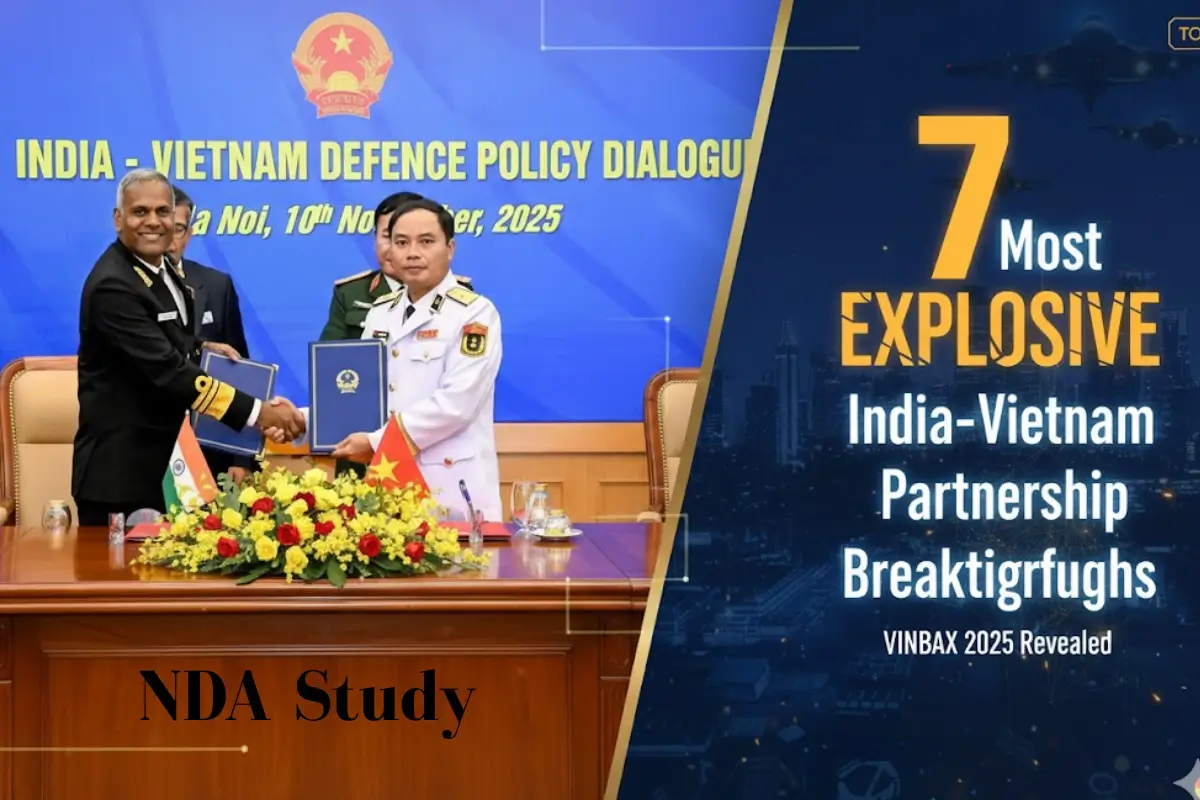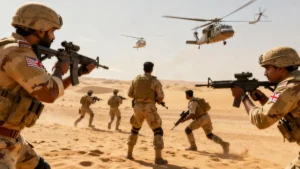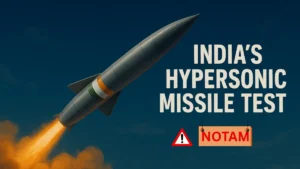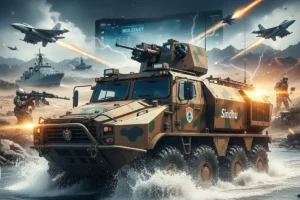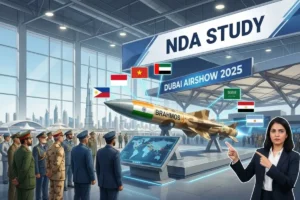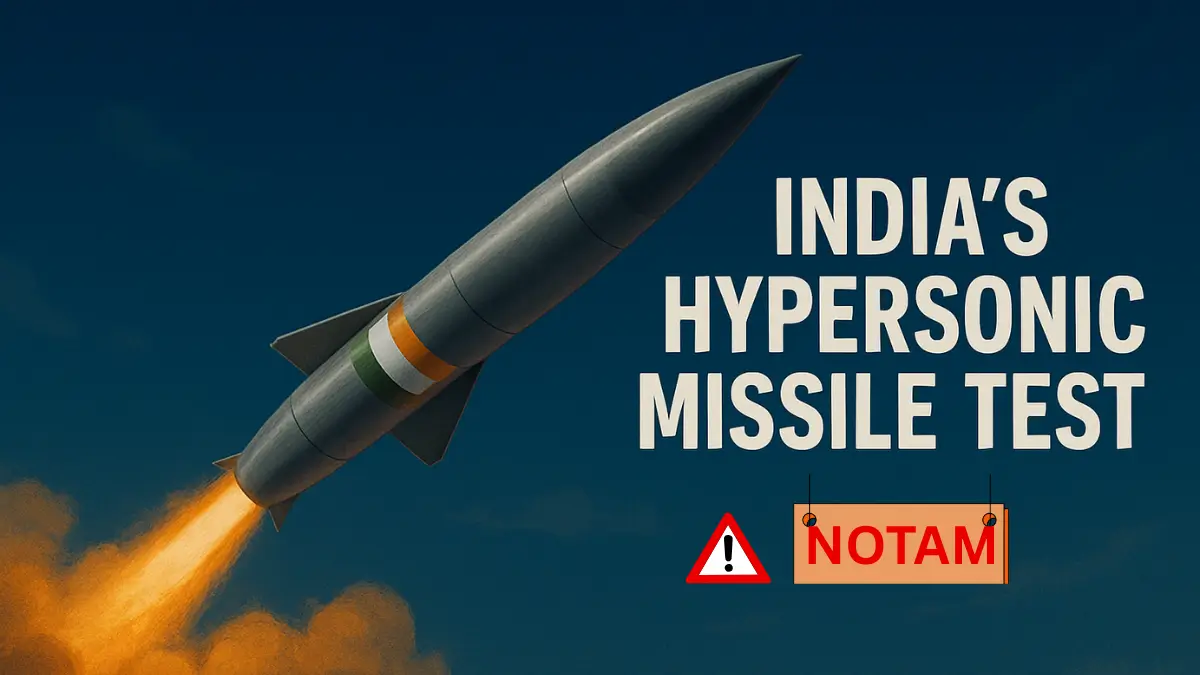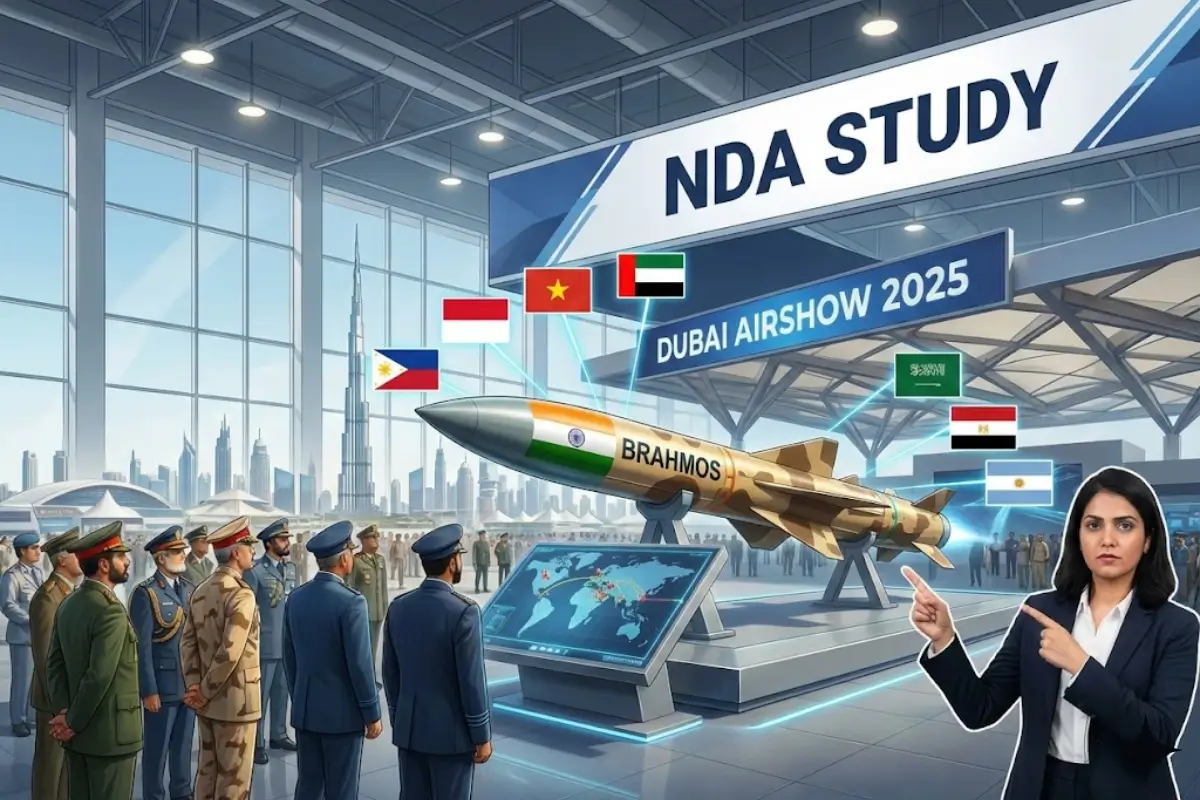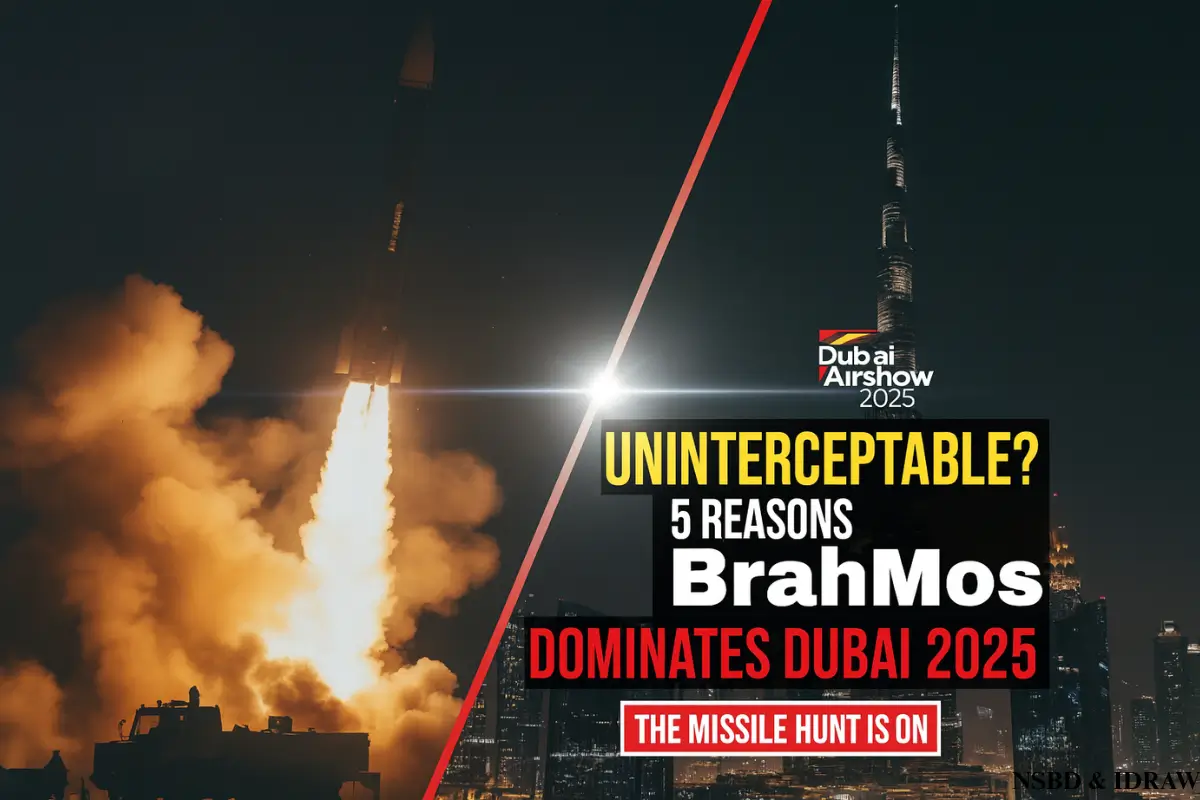Wait. Stop scrolling. Here’s what just happened: India and Vietnam just executed the most strategic defence partnership breakthrough in Southeast Asia’s history. 6 editions. 4 field-based exercises. 300+ military personnel deployed right NOW. 18 consecutive days of intensive UN peacekeeping training. 2 historic agreements that just fundamentally reshaped bilateral defence cooperation. And ONE undeniable reality: India is Vietnam’s ONLY international partner conducting annual field-based UN peacekeeping drills.
This isn’t diplomatic theatre. This is an operational reality reshaping the Indo-Pacific. On November 10–11, 2025, during the 15th Defence Policy Dialogue in Hanoi, India and Vietnam didn’t just exchange business cards. They signed a Memorandum of Agreement on Submarine Search & Rescue Support Cooperation—enabling joint maritime emergency response in real-time. They signed a Letter of Intent on Defence Industry Collaboration—merging “Make in India” manufacturing with Vietnam’s Hong Ha Shipyard in a partnership that’s already producing defence systems together. And they launched VINBAX 2025—running November 11–27—the most comprehensive UN peacekeeping exercise ever designed between any two nations in this region.
What unfolds over the next 18 days is being watched obsessively by China, Russia, Japan, and every ASEAN power, trying to understand India’s emerging regional dominance. Here are the 7 game-changing breakthroughs this India-Vietnam defence cooperation partnership just revealed—and why they matter more than you think.
1️⃣ India: Vietnam’s ONLY International UN Peacekeeping Partner
The Jaw-Dropping Reality: China? No. Russia? No. Japan? No. Australia? No. ASEAN nations? No. USA? No. Only India. Vietnam could partner with anyone on the planet. Instead, Vietnam explicitly chose India—and ONLY India—for exclusive annual field-based UN peacekeeping bilateral exercises. This exclusivity isn’t accidental. It’s calculated strategic positioning.
Why This Matters (The Part Nobody’s Saying): This exclusivity signals Vietnam’s long-term strategic bet on India as its preferred defence partner. In a region where geopolitical alignment is everything, exclusivity is currency. When Vietnam says “India is our ONLY international UN peacekeeping partner,” it’s not just logistics—it’s a geopolitical statement heard in Beijing, Moscow, and Washington.

The Numbers Behind the Exclusivity: India contributes over 300,000 personnel across 51 UN missions globally—making India the world’s largest UN peacekeeping troop contributor. Vietnam, expanding its UN peacekeeping portfolio, needed the best trainer. It found one. And locked it down exclusively for VINBAX bilateral exercises.
The Geopolitical Implication That Keeps China Up at Night: Exclusivity strengthens India’s Act East Policy more powerfully than any written policy document could. China watches this carefully. Japan watches. ASEAN watches. This is soft power at its finest—India becoming Southeast Asia’s most trusted defence partner not through military dominance but through institutional reliability and demonstrated competence in UN peacekeeping.
2️⃣ India-Vietnam Move from Partners to Allies
What Just Got Signed (And Why It’s Absolutely Historic): The Memorandum of Agreement on Submarine Search & Rescue Support Cooperation, signed November 10, 2025, isn’t a routine agreement. It’s the first-ever framework establishing coordinated submarine emergency response protocols between India and Vietnam.
What This Actually Enables (The Real-World Implications):
- Joint submarine emergency response operations in Indo-Pacific waters—operational alliance status
- Real-time crisis coordination when submarines face emergencies—no bureaucratic delays when lives are at stake
- Personnel and equipment interoperability between the Indian Navy and the Vietnam People’s Navy—true naval integration
- Shared submarine rescue expertise from India’s extensive naval experience—decades of operational knowledge transfer
The Hidden Strategic Significance Nobody’s Discussing: This MoA moves India-Vietnam defence cooperation relationship from “dialogue partner” to “operational ally capable of handling real emergencies.” During actual submarine crises, this agreement becomes lifesaving. For a region where submarine operations are intensifying (Vietnam operates Kilo-class submarines; India operates advanced nuclear and conventional submarines), this cooperation becomes strategically critical.
Why This Matters for Indo-Pacific Stability: Submarine accidents historically cause international incidents. This MoA prevents escalation. When submarines need rescue, coordination protocols override political tensions. India-Vietnam is essentially saying: “We trust each other enough to handle maritime emergencies jointly”—a statement of unprecedented operational cooperation.
Officers specialising in submarine operations, maritime safety, and emergency response protocols will find explosive growth in demand as India-Vietnam expands this cooperation.
3️⃣ Defence Manufacturing Revolution
The Game-Changer That Just Got Signed: The Letter of Intent on Defence Industry Collaboration, signed alongside the submarine MoA, encompasses something massive: technology transfer, joint production ventures, defence procurement cooperation, and design-manufacture linkages.
The Real-World Application (Not Theoretical):
- Hong Ha Shipyard (Vietnam’s defence facility) + Indian shipbuilding expertise = co-produced defence systems
- Technology transfer from India’s growing indigenous defence ecosystem—not import-dependent solutions
- Reduced import dependence for both nations—self-reliant defence ecosystems
- Export opportunities for Indian defence manufacturers entering Southeast Asia markets—Make in India goes regional
The Context That Makes This EXPLOSIVE: India already delivered six high-speed boats to Vietnam—five built in India by Larsen & Toubro, one at Hong Ha Shipyard. This LoI scales up that model exponentially.
What Makes This Absolutely Revolutionary: This LoI aligns directly with India’s Atmanirbhar Bharat (Self-Reliant India) vision. For the first time, India is exporting not just products but entire manufacturing capabilities and technology ecosystems to Southeast Asia. This opens commercial pathways for Indian defence companies (HAL, BEL, L&T) to expand regionally without competing directly with global giants.
Why NDA Aspirants & Defence Professionals Should Be PAYING ATTENTION: This creates an explosion of career opportunities:
1. Defence manufacturing engineers needed for joint production
2. Shipyard modernization experts
3. Technology transfer specialists
4. Supply chain managers for bilateral defence projects
5. Officers in defence industry liaison roles
The next 5 years will see massive hiring in defence manufacturing as this LoI operationalizes.
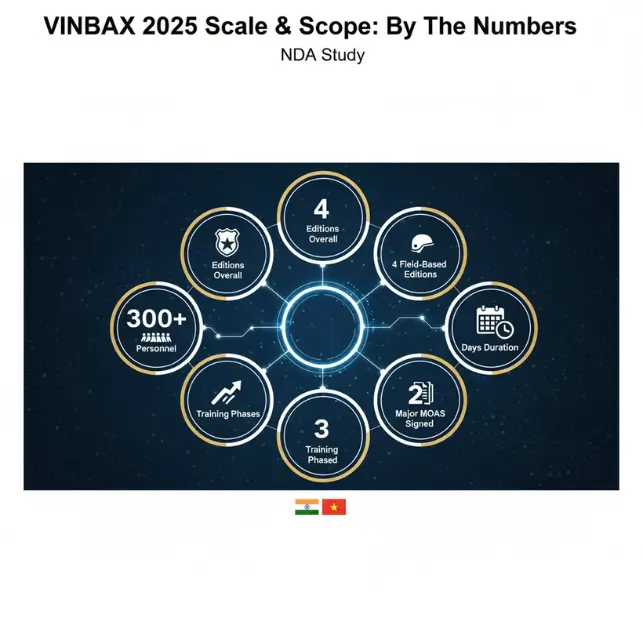
4️⃣ Massive Scale, Real-World Realism
The Scale That Proves Seriousness:
- ~300 military personnel deployed RIGHT NOW (not 50 officials in a conference room)
- 18 consecutive days of intensive operations (not a 3-day ceremonial drill)
- Three-phase training mimicking actual UN peacekeeping deployment workflows
- Advanced equipment and simulation technology creating realistic mission conditions—this is operational training, not diplomatic theatre
The Three-Phase Progression (How This Actually Works):
Phase 1 (Nov 11–15): Classroom Immersion
UN protocols, peacekeeping standards, rules of engagement—a theoretical foundation built by Defence Secretary Singh and his Indian team, coordinated with Vietnam’s military leadership.
Also Read:
DRDO tested K-5 SLBM Stage-2 Motor Successfully: India’s Nuclear Triad Sea-Leg Breakthrough
Delhi Defence Dialogue 2025: India’s New-Age Defence Technology Revolution Explained
World’s Highest Fighter Base: India’s Nyoma Airbase at 13,700 Feet Operationalised Near LAC
Phase 2 (Nov 16–24): Hands-On Technical Mastery
Engineering operations (bridge construction, mine clearance, infrastructure repair under operational constraints), field medical response (trauma surgery in austere conditions, triage protocols), search-and-rescue operations (underwater operations, personnel extraction).
Phase 3 (Nov 25–27): Large-Scale Integrated Field Drills
Realistic UN mission simulations with time pressure, resource constraints, inter-unit coordination challenges—this is what actual UN deployment feels like.
Why Scale MATTERS (The Part That Makes This Historic): VINBAX 2025 isn’t ceremonial military theatre. Participants experience the actual complexity they’ll face in real UN deployments. When 300+ personnel spend 18 consecutive days in realistic field conditions with advanced equipment, that’s operational preparation at scale—not diplomatic posturing.
The Strategic Implication: Both India and Vietnam are broadcasting to the world: “We’re serious about UN peacekeeping contributions. Our forces are deploy-ready.” This scale signals commitment, not token gestures.
5️⃣ How VINBAX Went From Tabletop Exercises (2018–2019) to Field Operations (2024–2025)
The Evolution That Tells the Real Story:
- VINBAX 2018–2019 (Editions 1–3): Tabletop exercises, theoretical scenario planning—foundational
- VINBAX 2024–2025 (Editions 4–6): Field-based operations with heavy equipment, realistic simulations—operational maturity
Why This Evolution MATTERS (More Than You Realise): This isn’t just adding complexity; it’s demonstrating partnership maturity in real-time. Tabletop exercises are foundational—necessary but limited. Only operationally serious partnerships graduate to field exercises. The fact that India-Vietnam VINBAX progressed this way signals institutional commitment evolving over 7 years.
What This Progression Tells About Bilateral Depth: If India-Vietnam ties were transactional or ceremonial, they’d remain at the dialogue stage indefinitely. Instead, they’ve evolved to operational integration—field exercises with hundreds of personnel, submarine MoAs, and manufacturing LoIs. This progression trajectory mirrors partnerships between NATO allies or long-established bilateral relationships with decades of history.
The Geopolitical Signal: China’s military partnerships rarely progress this way—they remain at the equipment-sales stage. Russia’s Southeast Asian partnerships similarly plateau at the transaction level. Only India-Vietnam demonstrates this institutional maturation—suggesting unprecedented strategic alignment reshaping the region.
6️⃣ Emerging Cooperation Frontiers
The EXPLOSIVE New Domains Both Nations Just Committed To:
During the 15th Defence Policy Dialogue, India and Vietnam didn’t just sign submarine and manufacturing agreements—they explicitly agreed to explore cooperation in SIX emerging domains that represent where 21st-century defence competition actually happens:

1. Cybersecurity & Defence IT Infrastructure
Joint frameworks for protecting defence networks, sharing cyber threat intelligence, and developing indigenous cybersecurity solutions. As militaries digitise, cybersecurity becomes existential.
2. Military Medicine & Medical Innovation
Expanded exchange programs, tropical disease management, epidemic response protocols, and field surgical training. Medical readiness determines UN peacekeeping success.
3. Advanced Search & Rescue Operations
Underwater SAR, disaster response SAR, and cross-border coordination mechanisms. These skills save lives in humanitarian disasters.
4. Hydrographic Cooperation & Maritime Domain Awareness
Joint maritime surveys, domain awareness data-sharing, coordinated sea lane mapping. Hydrography is strategic intelligence disguised as navigation data.
5. Artificial Intelligence in Defence Systems
Autonomous systems, predictive analytics for intelligence, and AI-assisted command-and-control. AI is the weapons system of the future.
6. Shipyard Modernisation & Advanced Manufacturing
Technology transfer for naval architecture, advanced systems integration, and next-generation design collaboration.
Why This Matters (The Strategic Significance): These emerging domains represent where modern defence competition occurs—not traditional warfare but cyber-resilience, medical readiness, autonomous systems, maritime intelligence. By committing to joint exploration HERE, India and Vietnam position themselves at the FRONTIER of defence innovation rather than remaining dependent on external technologies.
The Future Roadmap (Already Officially Scheduled):
- December 2025: Next Defence Industry Cooperation meeting scheduled
- 2026: 16th Defence Policy Dialogue in India
- Late 2026: Vietnam International Defence Expo with India’s participation
- 2027+: Ongoing annual VINBAX editions + emerging domain breakthroughs
For Defence Professionals & NDA Aspirants: These emerging domains create explosive career opportunities. Officers specialising in cybersecurity, military medicine, AI applications, and hydrographic operations will find EXPLODING demand as India-Vietnam expand cooperation across these frontiers.
7️⃣ Strategic Indo-Pacific Positioning
The Bigger Picture (What This Really Means):
VINBAX 2025 doesn’t occur in a geopolitical vacuum. It’s a calculated move by both nations signalling long-term strategic alignment, operational readiness, and unwavering commitment to regional stability amid rising tensions in the Indo-Pacific.
Vietnam’s Geopolitical Position:
- Frontline state facing South China Sea territorial tensions
- Balancing China relations while diversifying strategic partnerships
- Needs defence capabilities independent of single-supplier reliance
- Chooses India (and ONLY India) for exclusive UN peacekeeping partnership = strategic signal
India’s Regional Strategy:
- Act East Policy positioning India as Southeast Asia’s preferred defence partner
- UN peacekeeping expertise as soft power currency
- Defence manufacturing as economic statecraft
- VINBAX 2025 = Act East Policy operationalised in real-time
The Strategic Alignment:
- India contributes 300,000+ personnel to 51 UN missions (global leadership)
- Vietnam is expanding its UN peacekeeping portfolio (capacity-building with India)
- ASEAN nations are watching the India-Vietnam precedent (observing how India operates)
- Indo-Pacific geopolitical competition (China/Russia observing India’s regional positioning)
Why This Matters GLOBALLY (The Part That Affects You):
- For India: Reinforces positioning as Southeast Asia’s most trusted defence partner—a positioning extending far beyond bilateral relations into India’s broader Indo-Pacific strategy and geopolitical influence
- For Vietnam: Provides access to the world’s largest peacekeeping contributor; strengthens sovereignty through diversified partnerships; builds indigenous defence capabilities
- For ASEAN: Vietnam-India model demonstrates how smaller nations build strategic depth through institutional partnerships rather than military dominance—a template other nations are watching
- For China/Russia: Signals India’s growing regional influence through soft power (training, capacity-building, manufacturing partnerships) rather than military coercion—and they’re not happy about it
- For Global Stability: Demonstrates commitment to rules-based Indo-Pacific order against rising tensions and geopolitical competition
| Actor | What They’re Watching | What VINBAX 2025 Signals |
|---|---|---|
| 🇨🇳 China | India’s regional influence expansion | India is emerging as a defence technology provider in Asia |
| 🇷🇺 Russia | India-Vietnam military interoperability | India is building operational alliances, not just diplomatic ties |
| 🏳️ ASEAN | India’s partnership model with Vietnam | India emerging as a defence technology provider in Asia |
| 🇺🇸 USA | India’s Indo-Pacific strategic positioning | India is advancing the rules-based order through defence partnerships |
| 🇯🇵 Japan | India-Vietnam cooperation depth | India offers an alternative to transactional defence relationships |
The Bottom Line: VINBAX 2025 is a geopolitical statement watched obsessively by global powers. It’s not just bilateral exercise—it’s India demonstrating regional leadership, Vietnam diversifying strategic partnerships, and both nations strengthening the rules-based Indo-Pacific order against rising tensions.
FAQs|Exercise VINBAX 2025
1. Why is India Vietnam’s ONLY international UN peacekeeping partner—and not China, Russia, Japan, or the USA?
Exceptional strategic trust + India’s proven UN peacekeeping expertise (300,000+ personnel across 51 missions globally) + shared Indo-Pacific vision. Vietnam explicitly chose India—and ONLY India—for exclusive annual field exercises. This isn’t an accident; it’s a strategic calculation. India is the most trusted trainer, and Vietnam locked that relationship down exclusively.
2. What does the submarine MoA actually enable operationally?
Real-time crisis coordination, joint emergency response protocols, and personnel/equipment interoperability. During actual submarine emergencies, this agreement prevents escalation and enables coordinated rescue operations. It moves India-Vietnam from “dialogue partners” to “operational allies capable of handling maritime emergencies jointly.”
3. How does the defence manufacturing partnership benefit India and Vietnam?
For India: Export market access in Southeast Asia + operational manufacturing experience + positioning as a defence technology provider to ASEAN + validation of Make in India capabilities. For Vietnam: Reduced import dependence + indigenous capability building + technology transfer + self-reliant defence ecosystem.
4. What makes VINBAX 2025 different from previous editions?
Evolution from tabletop (2018–2019) to field-based operations (2024–2025). 300+ personnel, 18-day intensive training, three-phase realistic mission preparation—not ceremonial theatre.
5. How does this strengthen India’s Act East Policy?
Operationalises India’s strategic positioning as Southeast Asia’s trusted defence partner. Vietnam’s exclusive choice of India signals India’s emerging regional leadership through institutional partnerships and capacity-building—not military dominance.
6. What emerging domains will India-Vietnam explore next?
cybersecurity, military medicine, advanced SAR, hydrography, AI applications in defence, and shipyard modernisation. December 2025 industry meeting, 2026 Defence Policy Dialogue, and late 2026 Defence Expo participation are already scheduled.
7. Why should non-defence people care about VINBAX 2025?
This shapes regional geopolitics, trade relationships, technology partnerships, broader Indo-Pacific stability, global supply chains, and international order. If you care about global stability, defence exports, technology development, or geopolitical power dynamics—VINBAX matters.
What’s Next
Over the next 18 days (November 11–27), 300+ military personnel will demonstrate precisely how serious this partnership truly is. The submarine MoA, defence manufacturing LoI, and annual UN peacekeeping exercises aren’t ceremonial gestures—they’re institutional mechanisms creating operational reality. India became Vietnam’s ONLY international partner conducting field-based UN peacekeeping exercises annually. This exclusivity reshapes the Indo-Pacific. China watches. Russia watches. ASEAN watches. This bilateral exercise signals India’s emerging role as Southeast Asia’s most trusted defence partner.
December 2025 Defence Industry meeting. 2026 Defence Policy Dialogue in India. Late 2026 Vietnam International Defence Expo with Indian participation. 2027+ expanded VINBAX editions with emerging tech integration. This partnership trajectory extends into the next decade. VINBAX 2025 is the foundation, not the peak. Watch this space carefully—because what unfolds here reshapes regional geopolitics.
